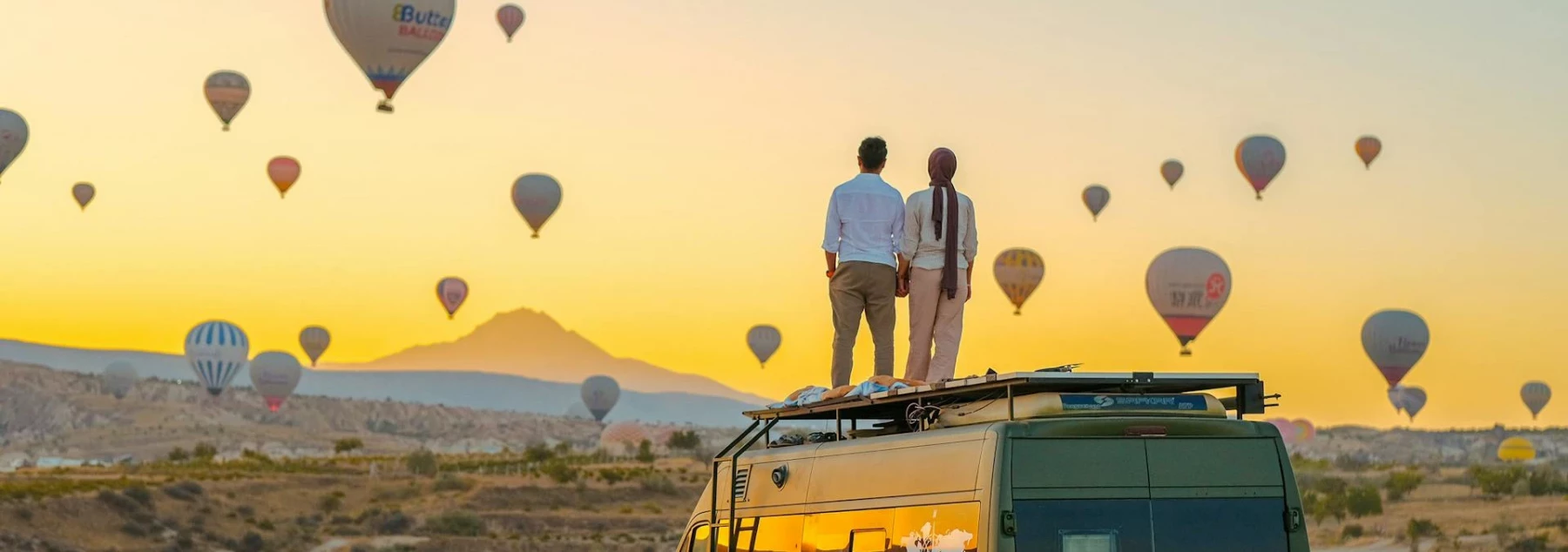To visit - Cappadocia
Cappadocia, a geological wonder nestled in the heart of Turkey, captivates with its unique and extraordinary landscapes. The famous fairy chimneys, conical rock formations sculpted by erosion, give the region an enchanting character. Within these formations, underground cities like Derinkuyu and Kaymaklı bear witness to the ingenuity of ancient inhabitants, offering mazes of rooms, kitchens, and churches carved into the rock for protection against invasions.
The cave churches, adorned with frescoes dating back to the early centuries of Christianity, turn Cappadocia into an open-air museum. The magic reaches its peak during hot air balloon flights at sunrise, allowing visitors to marvel at the splendor of valleys and rock formations from the skies. The Love Valley and Rose Valley, with their picturesque trails, invite unforgettable hikes amidst this fairy-tale landscape.
Local markets reveal the exceptional craftsmanship of Cappadocia, where handmade carpets, pottery, and jewelry captivate enthusiasts of authenticity. Finally, the local cuisine, featuring dishes like manti and testi kebab, offers a delight for the taste buds, completing the overall sensory experience in this region of unparalleled charm. Cappadocia stands as a destination where history, nature, and culture harmoniously converge to create a memorable adventure.
The 8 essential things to do in Cappadocia :
Summary
1 - Hot air balloon flight
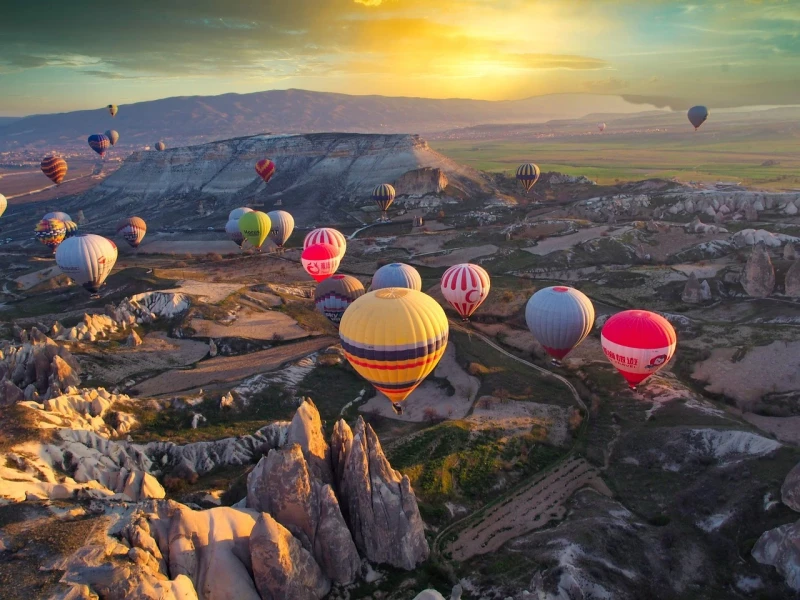
Hot air ballooning in Cappadocia is an iconic and unforgettable experience. Here's what you can expect during a hot air balloon ride in this spectacular region of Turkey:
-
Sunrise: Hot air balloon flights in Cappadocia typically take place at sunrise. It's one of the most magical times of the day, as the soft morning light illuminates the rock formations, creating a fairy-tale atmosphere.
-
Preparation and Takeoff: The experience begins with your arrival at the takeoff site, where you can witness the preparation of the balloon. Balloon crews handle the inflation of the balloon as you watch this captivating spectacle. Once the balloon is ready, you'll board the basket.
-
Panoramic Views: Once in the air, you'll enjoy breathtaking panoramic views of Cappadocia's unique landscapes. Conical rock formations, green valleys, traditional villages, and cave churches unfold beneath you.
-
Peace and Serenity: Hot air balloon flights provide a peaceful and serene experience. Apart from the occasional sound of the gas burner maintaining the balloon's altitude, silence reigns at higher altitudes, creating a magical atmosphere.
-
Flight Duration: Hot air balloon flights in Cappadocia typically last around one hour, providing ample time to appreciate the beauty of the diverse landscapes and capture memorable photos.
-
Landing and Ceremony: Once the flight concludes, the balloon descends gently for a safe landing. A traditional ceremony, often involving the presentation of flight certificates, may take place, marking the end of this unique experience.
-
Breakfast: Many hot air balloon companies offer a post-flight breakfast, often featuring local products and beverages, providing an opportunity to celebrate this adventure.
It's highly recommended to book your hot air balloon flight in advance, as this activity is very popular among visitors to Cappadocia. It's an experience that will be etched in your memory as one of the most magical moments of your trip.
 Our tips for getting the most out of your experience.
Our tips for getting the most out of your experience.
Taking a hot air balloon ride in Cappadocia is an extraordinary experience, and here are some tips to make the most of it:
-
Book in Advance: Hot air balloon rides are highly sought after in Cappadocia, especially during the high season. Make sure to book your flight in advance to secure a spot, especially if you have specific dates in mind.
-
Choose a Reputable Provider: Opt for a well-established and reputable hot air balloon company. Check online reviews and ask for recommendations to ensure a safe and enjoyable experience.
-
Prepare for Sunrise: Balloon flights typically take place early in the morning at sunrise. Dress warmly, as temperatures can be cool, especially in the early hours.
-
Have Your Camera Ready: Ensure your camera or smartphone has enough battery and storage space. The views from the hot air balloon are spectacular, and you'll want to capture these memorable moments.
-
Follow Safety Instructions: Pay close attention to the safety instructions provided by the balloon crew before takeoff. It is essential to follow procedures to ensure a safe experience.
-
Choose Your Side of the Basket: Ask the crew which side of the basket will offer the best views based on weather conditions and the planned route.
-
Be Flexible with Dates: If possible, be flexible with the dates for your hot air balloon ride. Weather conditions can impact flights, and having some flexibility allows you to choose the ideal day.
-
Enjoy the Moment: During the flight, take the time to immerse yourself in the experience. Put your camera aside at times to simply appreciate the panorama and soak in the unique atmosphere.
-
Post-Flight Breakfast: Most hot air balloon companies offer a post-flight breakfast. Take advantage of this opportunity to chat with other passengers and share your experiences.
-
Congratulations at Landing: Many flights end with a certificate presentation ceremony. Accept your flight certificate with pride and congratulations for completing this exceptional experience.
By following these tips, you'll be better prepared to fully enjoy your hot air balloon ride in Cappadocia, creating lasting memories.
2 - Explore the rock churches
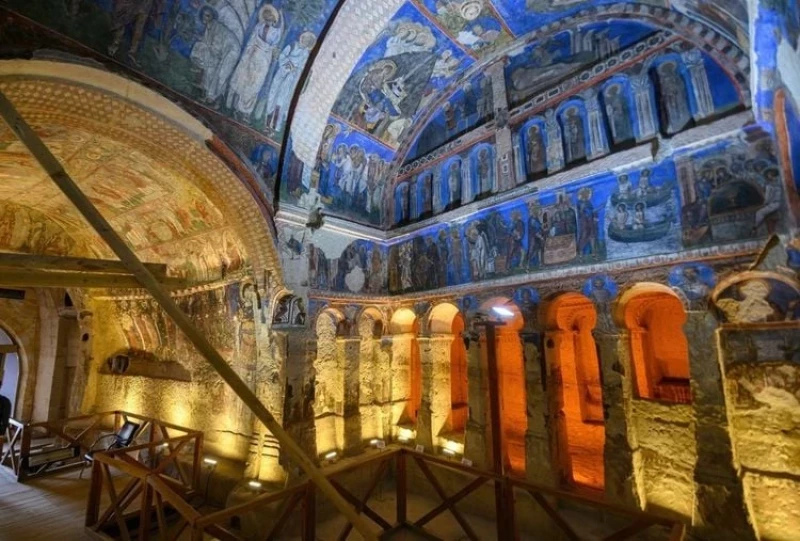
Exploring the rock-cut churches in Cappadocia is a captivating journey through historical and artistic treasures nestled within the heart of spectacular rock formations. The open-air museum of Göreme, featuring the Dark Church with its remarkable frescoes, provides an immersive introduction to this exceptional heritage. The Zelve Valley unveils a troglodyte city with rock-cut churches, revealing insights into ancient communal life.
The fairy chimneys of Paşabağ Valley conceal churches like the Church of Saint-Simeon, illustrating the unique symbiosis between nature and spirituality. The Göreme Valley, dotted with troglodyte churches like the Apple Church, portrays a rich artistic and religious tapestry. In Devrent Valley, churches with peculiar shapes spark the imagination, while the Kılıçlar Valley offers troglodyte churches against a picturesque backdrop.
The Rose and Love Valleys complete this tableau with churches like Kolonlu Kilise, blending rock-cut architecture and artistic expressions. Each rock-cut church unveils vibrant frescoes telling biblical tales, portraits of saints, and religious symbols, providing a fascinating dive into Byzantine spirituality. This exploration offers a profound understanding of Cappadocia's unique history and culture, blending ancient art with the natural splendor in a truly extraordinary way.
 Our tips for getting the most out of your experience.
Our tips for getting the most out of your experience.
Exploring the rock-cut churches in Cappadocia can be a rewarding experience, and here are some tips to make the most of it:
-
Plan Your Itinerary: Cappadocia has several rock-cut church sites. Plan your itinerary based on the sites you want to visit, considering their proximity to each other.
-
Opt for a Guided Tour: A guided tour can provide in-depth information on the history, architecture, and art of the rock-cut churches. Local guides can share fascinating details that you might otherwise miss.
-
Check Opening Hours: Make sure to know the opening hours of the sites you plan to visit. Some sites may have specific hours, and it's important to factor them into your planning.
-
Purchase Necessary Tickets: Some rock-cut church sites may require the purchase of entrance tickets. Get the necessary tickets in advance to avoid unnecessary delays on-site.
-
Wear Comfortable Shoes: Exploring rock-cut churches may involve walking and navigating sometimes uneven terrain. Wear comfortable shoes for a more enjoyable experience.
-
Respect Conservation Rules: Some rock-cut churches may have strict rules for the preservation of frescoes and structures. Respect these rules by avoiding touching the frescoes and following the site's guidelines.
-
Bring Water and Snacks: It's always a good idea to have water and light snacks with you, especially if you plan to spend a considerable amount of time exploring the rock-cut churches.
-
Prepare Your Camera: The frescoes and artistic details of the rock-cut churches are worth photographing. Ensure you have a camera with enough battery and storage space.
-
Take Time to Appreciate: Don't rush from one church to another. Take the time to appreciate the details of the frescoes, absorb the unique atmosphere, and imagine the life that once animated these places.
-
Learn about the History: Before your visit, read up on the history of Cappadocia and the rock-cut churches. This will enrich your experience by providing context to the artworks you'll discover.
By following these tips, you'll be better prepared to explore Cappadocia's rock-cut churches in an educational and immersive manner.
3 - Discover underground cities
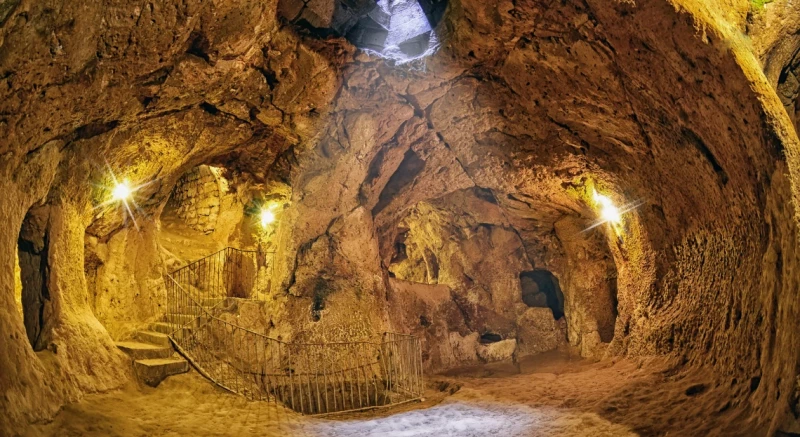
Cappadocia is renowned for its underground cities, fascinating structures carved into volcanic rock to serve as shelters and protective spaces. Here are some of the most notable underground cities in Cappadocia:
-
Derinkuyu: Derinkuyu is one of the largest underground cities in Cappadocia, capable of accommodating up to 20,000 people. It comprises multiple levels with residential areas, churches, kitchens, and storage rooms.
-
Kaymaklı: This underground city is also extensive and well-preserved. It features intricate corridors, rooms with furniture carved into the rock, spaces for livestock, cellars, and even a church.
-
Özkonak: While smaller than Derinkuyu and Kaymaklı, the underground city of Özkonak provides an immersive experience with its winding tunnels and functional chambers.
-
Mazi: Less known than others, the underground city of Mazi is an ongoing archaeological site undergoing restoration. It offers a unique glimpse into ancient underground life.
-
Tatlarin: This less-visited underground city offers a more intimate atmosphere. It showcases similar features to other underground cities, with living and storage spaces.
-
Gaziemir: Although smaller, the underground city of Gaziemir is known for its well-preserved structures and sophisticated system of tunnels and chambers.
-
Kayalıdere: Located near the town of Nevşehir, Kayalıdere is another underground city with narrow passages, rooms, and storage areas.
These underground cities were initially constructed for security purposes, allowing the inhabitants of Cappadocia to protect themselves against invasions and attacks. They testify to the architectural ingenuity and resourcefulness of the region's residents in the face of historical challenges. Visitors can explore these sites to discover the architectural brilliance and how these subterranean spaces were utilized in the past.
 Our tips for getting the most out of your experience.
Our tips for getting the most out of your experience.
Discovering the underground cities of Cappadocia can be a unique and fascinating experience. Here are some tips to make the most of it:
-
Choose the right time of day: Some underground cities may be busier at certain times of the day. Plan your visit early in the morning or late in the afternoon to avoid crowds.
-
Opt for a guided tour: A guided tour can provide in-depth information about the history, architecture, and cultural significance of the underground cities. Local guides can share interesting details that you might not discover otherwise.
-
Wear comfortable clothing and sturdy shoes: Some areas of the underground cities may be narrow or have uneven passages. Dress comfortably and wear suitable shoes for exploration.
-
Study a bit of history before your visit: Familiarizing yourself with the history of Cappadocia's underground cities before your visit can make the experience more enriching. It will help you appreciate the details you encounter.
-
Respect conservation rules: Some areas of the underground cities may have strict rules for preserving structures and frescoes. Respect these rules by avoiding touching surfaces and following the site's guidelines.
-
Bring water: Visits can be physically demanding, especially if it's hot. Make sure to have water with you to stay hydrated during exploration.
-
Prepare your camera: The underground cities offer unique photography opportunities. Ensure your camera is ready with enough battery and storage to capture memorable moments.
-
Be aware of your surroundings: Some parts of the underground cities may be dark or require extra attention due to narrow passages. Be aware of your surroundings and follow directions for safe exploration.
-
Take your time: Don't rush through the underground cities. Take the time to appreciate the architectural ingenuity and imagine the daily life that once unfolded in these spaces.
By following these tips, you'll be able to explore Cappadocia's underground cities in a more informed and immersive manner.
4 - Hiking in the valleys
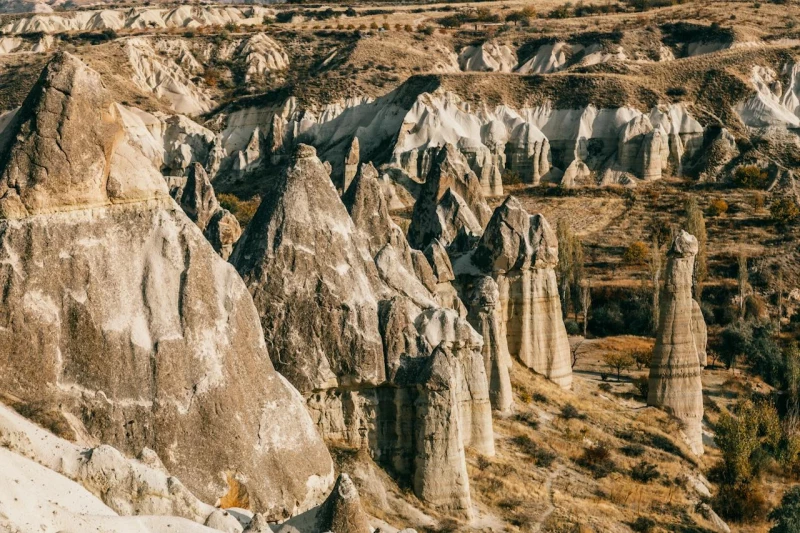
Cappadocia, a unique region in Turkey, is renowned for its picturesque valleys carved by natural erosion and adorned with unusual rock formations. Here are some of the iconic valleys of Cappadocia:
-
Göreme Valley: Located in the heart of Cappadocia, this valley is famous for its fairy chimneys, spectacular rock formations, and rock-cut churches. The Göreme Open Air Museum is also situated in this valley.
-
Zelve Valley: Known for its ancient troglodyte city, Zelve Valley features fairy chimneys, cave dwellings, and rock-cut churches. It provides a unique insight into daily life in a troglodyte community.
-
Rose Valley: Named for the pink hues of the rock formations at sunset, this valley offers scenic hiking trails and is home to several rock-cut churches.
-
Love Valley: Characterized by giant fairy chimneys, Love Valley is a picturesque hiking destination with panoramic views of Cappadocia.
-
Pigeon Valley: Named for the numerous pigeon houses carved into the rock formations, this valley provides spectacular views of the surrounding landscapes and is ideal for hiking.
-
Devrent Valley: Often called the Valley of Imagination, it is famous for its strange rock formations that resemble animals and characters.
-
Pasabag Valley: Known for its unique fairy chimneys, this valley offers extraordinary landscapes and houses rock-cut churches such as the Church of Saint-Simeon.
-
Sword Valley (Kılıçlar Valley): Also known as the Valley of Swords, it features unique rock formations and rock-cut churches.
These valleys are not only remarkable for their extraordinary geological formations but also provide opportunities for hiking, exploration, and discovering the historical and cultural richness of Cappadocia.
 Our tips for getting the most out of your experience.
Our tips for getting the most out of your experience.
Hiking in the valleys of Cappadocia offers an exceptional experience amidst spectacular landscapes. Here are some tips to make the most of your hikes in Cappadocia's valleys:
-
Choose the right valleys: Cappadocia has numerous valleys, each with unique features. Select valleys that align with your interests, whether it's rock formations, rock-cut churches, or panoramic views.
-
Prepare with comfortable shoes: Hikes can involve varied terrain. Opt for comfortable and sturdy hiking shoes to ensure an easy walk.
-
Check the weather: Cappadocia can experience weather variations. Check the weather forecast before your hike to dress accordingly and prepare any necessary equipment.
-
Start early in the morning or late in the day: Temperatures are generally cooler early in the morning or late in the day. Starting your hike at these times can make the experience more enjoyable.
-
Bring water and snacks: Staying hydrated during the hike is crucial. Carry a water bottle and light snacks to maintain your energy.
-
Follow marked trails: To avoid getting lost, stick to marked trails and follow the signs. Cappadocia's valleys can have numerous paths, so having a map or a hiking app can be helpful.
-
Respect the environment: Cappadocia is a preserved region with a rich history. Respect the environment by avoiding leaving litter and adhering to conservation rules.
-
Prepare your camera: Cappadocia's valleys offer breathtaking views. Ensure your camera is ready to capture the unique landscapes and rock formations.
-
Check the opening hours of rock-cut churches: If you plan to visit rock-cut churches along the way, check their opening hours and plan accordingly.
-
Learn about local flora and fauna: Discover more about the region's flora and fauna. Some valleys may host a variety of unique birds and plants.
By following these tips, you can fully enjoy your hikes in the valleys of Cappadocia, discovering the natural and cultural beauty of this exceptional region.
5 - Zelve, the open-air museum
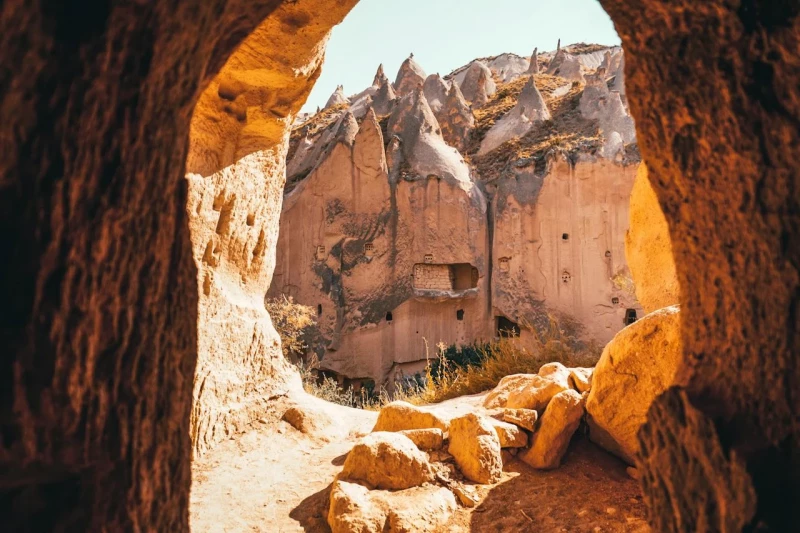
The Zelve Open Air Museum, located in the remarkable region of Cappadocia in Turkey, offers a fascinating dive into the unique history and architecture of the area. Nestled approximately 10 kilometers northeast of the town of Avanos, Zelve was once a village and a monastic refuge carved into the soft tuff rock. This historic site bears witness to the lives of Christians who sought refuge in the region, creating a community with cave dwellings, rock-cut churches, and communal spaces.
The Zelve Open Air Museum showcases a series of interconnected caves and tunnels, unveiling the architectural ingenuity of its inhabitants. These caves served residential, kitchen, storage, and religious purposes. The rock-cut churches in Zelve are adorned with frescoes, offering a captivating glimpse into Byzantine Christian art.
Gradually abandoned in the 20th century due to geological instabilities, Zelve was transformed into an open-air museum to preserve its rich heritage. Visitors can wander through the caves, exploring the historical labyrinth and immersing themselves in the mystical atmosphere of this troglodyte village. The well-preserved frescoes in the rock-cut churches stand out as highlights of the museum.
Today, the Zelve Open Air Museum provides an immersive experience, allowing tourists to discover the ancient way of life and the unique architecture of Cappadocia. The visit is self-guided, enabling visitors to appreciate the historical and cultural richness at their own pace. The site serves as a poignant testament to the evolution and abandonment of this troglodyte community, adding a particular dimension to the exploration of Cappadocia.
 Our tips for getting the most out of your experience.
Our tips for getting the most out of your experience.
Exploring the Zelve Open Air Museum in the Cappadocia region can be a rewarding experience. Here are some tips to make the most of your visit:
-
Dress Comfortably: Wear comfortable clothing and sturdy walking shoes, as you'll be exploring rocky areas and trails.
-
Visit Early Morning or Late Afternoon: To avoid crowds and enjoy a more peaceful atmosphere, plan your visit early in the morning or late in the afternoon.
-
Bring Water: It can get hot during the day, especially in summer. Ensure you have water with you to stay hydrated.
-
Avoid Touching Frescoes: If you visit rock-cut churches with frescoes, refrain from touching them, as contact can damage these delicate works of art.
-
Respect Conservation Rules: Follow the signs and conservation rules of the site to preserve its integrity.
-
Prepare Your Camera: The museum offers unique photographic opportunities. Ensure your camera is ready to capture these special moments.
-
Learn About the History: Before visiting Zelve, educate yourself about its history to better understand the structures you are about to explore.
-
Check Opening Hours: Make sure you know the museum's opening hours to plan your visit accordingly.
-
Explore at Your Own Pace: The museum offers self-guided tours, allowing you to explore at your own pace. Take the time to appreciate each detail.
-
Enjoy the Viewpoints: Some locations offer panoramic views of Cappadocia. Seek out these viewpoints for memorable panoramas.
By following these tips, you'll be able to fully enjoy your visit to the Zelve Open Air Museum, uncovering the captivating history of this troglodyte community and admiring the splendid frescoes in the rock-cut churches.
6 - Visit to Uchisar Fortress
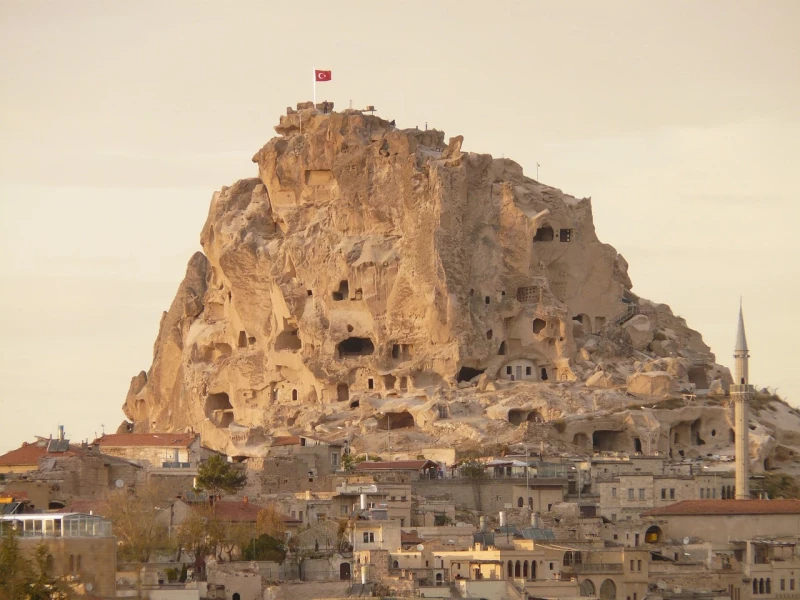
The Uçhisar Fortress, gracefully situated in the heart of Cappadocia, Turkey, stands as both a geological marvel and a historical treasure. Carved from the characteristic volcanic rocks of the region, this fortress is distinguished by its fairy chimneys and impressive conical formations, offering a visually unique spectacle. Its history traces back to the Byzantine era, bearing witness to centuries of evolution and modifications by different civilizations.
This exceptional site is more than just a fortress; it is a hollowed hill containing tunnels and chambers carved into the rock, once strategically used for surveillance and defense. Exploring the interior unveils ancient architectural ingenuity that defines Cappadocia.
The ascent to the fortress's summit reveals an invaluable reward: a 360-degree panoramic view of the surrounding valleys, unique geological formations, and the iconic fairy chimneys of Cappadocia. Uçhisar Fortress also serves as a prime vantage point for witnessing the enchanting sunrise or sunset over this captivating landscape.
Now open to visitors, Uçhisar Fortress offers an immersive experience that blends history, geology, and breathtaking panoramas. For an optimal visit, it is recommended to wear comfortable shoes, bring water, and delve into the fascinating history of this extraordinary site. Climbing its stairs and exploring its tunnels, visitors delve into the tumultuous history of Cappadocia, adding a unique historical and geological dimension to their journey.
 Our tips for getting the most out of your experience.
Our tips for getting the most out of your experience.
Visiting Uçhisar Fortress in the Cappadocia region can be a memorable experience. Here are some tips to make the most of your visit:
-
Wear Comfortable Shoes: The fortress includes rocky areas and stairs. Comfortable shoes are essential for exploration without discomfort.
-
Bring Water: Especially during hot days, make sure to have water with you to stay hydrated during the visit.
-
Learn About the History: Before your visit, familiarize yourself with the history of the fortress. This will enhance your experience by better understanding the historical elements you will encounter.
-
Prepare Your Camera: The fortress offers spectacular panoramic views. Ensure your camera is ready to capture these unique moments.
-
Visit Early Morning or Late Afternoon: To avoid crowds, consider visiting the fortress early in the morning or late in the afternoon. This allows you to enjoy a quieter atmosphere.
-
Explore Tunnels and Chambers: The fortress is more than just an exterior structure. Explore the tunnels and chambers carved into the rock for a more comprehensive experience.
-
Enjoy the Panoramic View: Once at the top, take the time to appreciate the 360-degree panoramic view of the surrounding valleys and geological formations.
-
Respect Site Rules: Follow the signs and rules of the site to preserve its integrity and ensure a pleasant experience for all visitors.
-
Check Opening Hours: Make sure you know the opening hours of the fortress to plan your visit accordingly.
By following these tips, you can fully enjoy your visit to Uçhisar Fortress, discovering its captivating history and appreciating the exceptional views of Cappadocia from this iconic site.
7 - Horseback or bike ride
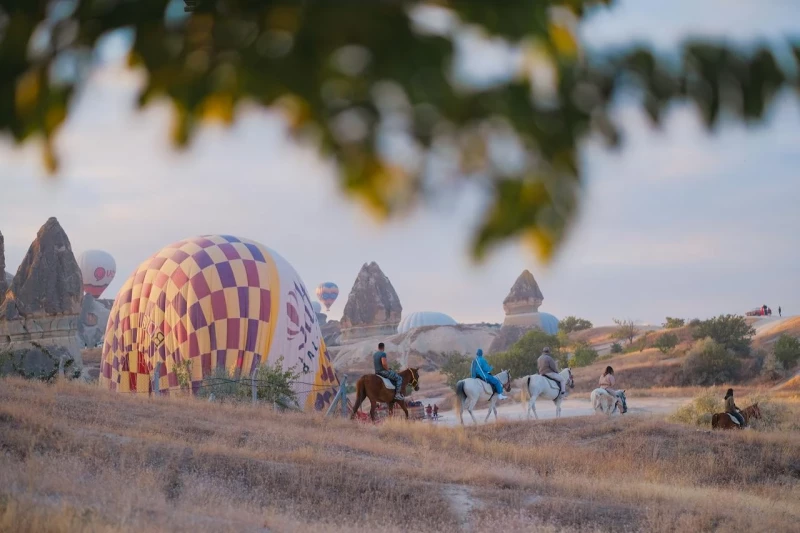
Horseback Riding:
-
Choose a Reliable Equestrian Center: Opt for a reputable equestrian center that offers well-maintained horses and experienced guides. This ensures a safer and more enjoyable experience.
-
Adapt the Trail to Your Level: Whether you're a beginner or an experienced rider, choose a trail that matches your skill level. Some routes are more suitable for beginners, while others may offer challenges for seasoned riders.
-
Prepare with Appropriate Attire: Wear comfortable and suitable attire for horseback riding. Closed-toe shoes and a helmet may be required, depending on the regulations of the equestrian center.
-
Enjoy the Landscape: Horseback riding allows you to fully immerse yourself in the unique landscape of Cappadocia. Take the time to appreciate the rock formations, valleys, and fairy chimneys while riding.
Biking:
-
Rent Quality Bikes: Opt for quality bikes and ensure they are well-maintained. Cycling routes in Cappadocia may involve varied terrain, so bikes suitable for different surfaces are recommended.
-
Explore Marked Trails: Cappadocia offers numerous marked trails for biking. Follow these routes for a safe exploration and to avoid getting lost.
-
Choose the Right Time of Day: Mornings and late afternoons are often the most pleasant times for a bike ride when temperatures are cooler.
-
Protect Yourself from the Sun: Due to the sunny climate, wear sunscreen, a hat, and sunglasses to protect yourself from UV rays during the ride.
-
Respect the Environment: Follow eco-friendly practices by respecting the natural environment of Cappadocia. Avoid veering off marked trails to preserve the ecosystem.
Whether you choose to saddle up on horseback or pedal on a bike, exploring Cappadocia this way offers a unique perspective on its enchanting landscapes.
8 - Craft workshops
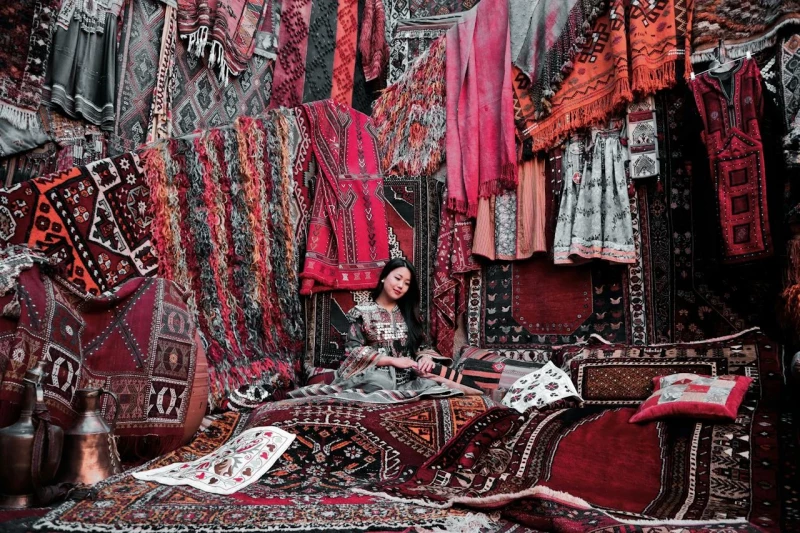
The Cappadocia region is renowned for its rich artisanal heritage, and the area offers a variety of workshops where visitors can discover and participate in traditional crafts. Here are some examples of craft workshops you might find in Cappadocia:
-
Pottery: Pottery is an ancient tradition in Cappadocia. You can visit workshops where skilled potters create unique pieces using traditional techniques. Some places even allow you to try your hand at creating your own pottery.
-
Carpet Weaving: Turkish carpets are famous for their quality and beauty. Visit a carpet weaving workshop to see how these handmade carpets are created, from traditional looms to intricate patterns.
-
Leatherwork: Turkish leather craftsmanship is also renowned. In leatherwork workshops, you can witness the making of leather products such as bags, shoes, or accessories.
-
Calligraphy: Explore the delicate art of Ottoman calligraphy. Some workshops offer classes where you can learn the basics of this ancient form of artistic writing.
-
Jewelry Making: Meet jewelry artisans and discover the creation of traditional Turkish jewelry. Some workshops may even allow you to create your own pieces under the guidance of an expert.
-
Ceramic Art: In addition to pottery, Cappadocia is also famous for its artistic ceramic tiles. Explore workshops where artisans create decorative ceramic pieces.
-
Embroidery: Discover the art of Turkish embroidery. Embroidery workshops provide an immersion into this artistic tradition, with demonstrations and sometimes even classes.
-
Wood Carving: Some talented artisans work with wood to create traditional sculptures. Explore their workshops to see these creations taking shape.
Visiting these craft workshops in Cappadocia offers a unique opportunity to appreciate local art and culture, and you may even bring home authentic souvenirs crafted by passionate artisans.
 Our tips for getting the most out of your experience.
Our tips for getting the most out of your experience.
Exploring craft workshops in Cappadocia can be a rewarding experience. Here are some tips to make the most of this discovery:
-
Research in Advance: Before choosing a workshop, research the various crafts present in Cappadocia. This will help you select those that align most with your interests.
-
Opt for Interaction: Choose workshops that offer an interactive experience. Some places allow visitors to actively participate in creating a craft.
-
Ask Questions: Feel free to ask questions to the artisans. This can enhance your understanding of the craft, the techniques used, and the associated cultural history.
-
Respect the Artisans' Work: During your visit, respect the artisans' workspace. Avoid touching pieces under construction without permission.
-
Attend Demonstrations: If possible, choose workshops that provide live demonstrations. This allows you to see the creation process up close.
-
Learn Some Local Words: Learning a few basic words in Turkish can facilitate communication with local artisans and show respect for their culture.
-
Bring a Notebook: Take notes on what you learn during your visit. This can be useful to remember specific details about the crafts.
-
Support Local Artisans: If you appreciate the work of an artisan, consider purchasing a piece from their workshop. This helps support local craftsmanship and preserves these traditions.
-
Check Opening Hours: Before heading out, make sure you know the workshop's opening hours. Some places may have specific hours for demonstrations or interaction.
-
Be Open to Learning: Be open-minded and ready to learn. Craft workshops offer a unique chance to deepen your understanding of traditional Cappadocian crafts.
By following these tips, your exploration of craft workshops in Cappadocia will not only be educational but also rewarding, allowing you to immerse yourself further in the cultural richness of the region.
Cappadocia - Where to Stay?
In Cappadocia, there are several charming towns and villages where you can choose to stay, each offering a unique atmosphere and a variety of accommodation options. Here are some popular places to stay in Cappadocia:
-
Göreme: This is one of the most central and popular towns in the region. Göreme offers a range of accommodations, from charming hotels to family-run guesthouses, and is close to iconic sites such as the Göreme Open Air Museum and the surrounding valleys.
-
Urgup: Another centrally located town, Urgup boasts a beautiful selection of cave hotels and other types of accommodations. Urgup is known for its traditional architecture and laid-back atmosphere.
-
Uchisar: Dominated by an impressive fortress-like rock, Uchisar offers spectacular panoramic views. The cave hotels here provide a unique experience, and the town is well-positioned for exploring other attractions.
-
Avanos: Situated along the Kızılırmak River, Avanos is renowned for its craftsmanship, especially pottery. You'll find various accommodation options here, and the town is within reasonable distance from major tourist sites.
-
Ortahisar: This small town offers an authentic and quiet atmosphere with cave dwellings. It's a good choice if you're looking for a more local and less touristy experience.
-
Ürgüp: With its picturesque cobblestone streets, Ürgüp offers stylish hotels, local restaurants, and a pleasant atmosphere. It is well-located for exploring the surrounding areas.
-
Mustafapaşa: This former Greek town has fascinating architecture. It provides a quieter, off-the-beaten-path experience with charming accommodation options.
Make sure to choose your accommodation based on your personal preferences, the type of experience you're looking for, and its proximity to the sites you want to visit in Cappadocia. Most accommodations offer a warm and authentic ambiance, often in harmony with the unique landscape of the region.
Cappadocia - How to get around?
Getting around Cappadocia can be done in various ways depending on your preferences, the distance to cover, and the level of flexibility you desire. Here are several transportation options in Cappadocia:
-
Car Rental: Renting a car can be a convenient option for exploring Cappadocia, especially if you want the freedom to visit remote or less accessible locations. Roads are generally in good condition, and driving in the region provides great flexibility.
-
Shuttles and Taxis: Many towns in Cappadocia offer shuttle services to major tourist sites. Local taxis are also available for shorter trips or to take you to specific locations.
-
Bicycles or Scooters: For a more active experience, you can rent a bicycle or scooter to explore the valleys and small villages in the region. This is a great option for short-distance travel.
-
Public Transportation: There are public buses connecting major towns in Cappadocia, such as Göreme, Ürgüp, and Nevsehir. However, they may not be as frequent or convenient for visiting more remote or off-the-beaten-path locations.
-
Guided Tours: For a hassle-free experience, you can join guided tours that include transportation to major sites. This can be convenient if you prefer not to worry about logistics.
-
Walking: In more concentrated areas like Göreme, you can explore on foot. This allows you to take your time discovering small streets, artisan shops, and local restaurants.
The choice of transportation depends on your personal preferences, the duration of your stay, and the places you plan to visit. If you need specific advice on routes or transport options for a particular site, it can be helpful to ask your local accommodation or travel agencies on-site.
Cappadocia - Best period
The Cappadocia region offers a unique experience throughout the year, but the ideal time to visit depends on your preferences for climate and activities. Here is some information about the seasons in Cappadocia:
-
Spring (April to June): Spring is a popular time to visit Cappadocia. Temperatures are mild, flowers are in full bloom, and the green landscapes create a beautiful contrast with the rock formations. It's also an excellent season for outdoor activities like hiking.
-
Summer (July to August): Summer months can be hot in Cappadocia, with temperatures sometimes reaching 30°C or higher. However, it's also the time when the region is liveliest due to summer tourism. Nights are generally cooler, and it's the perfect time for hot air balloon flights.
-
Autumn (September to November): Autumn is another favorable time to visit. Temperatures are pleasant, autumn colors add extra beauty to the landscapes, and you can avoid the summer crowds. It's also a good time for outdoor activities.
-
Winter (December to March): Winter in Cappadocia can be cold, with temperatures often below freezing, but it creates a special charm. Snow-covered landscapes are beautiful, and cave hotels offer a unique experience. Note that some activities may be limited due to weather conditions.
In summary, the best time to visit Cappadocia depends on your personal preferences. If you prefer mild temperatures and green landscapes, spring and autumn are the best seasons. If you are looking for sunny days and cool nights for hot air balloon flights, summer might be ideal. For a unique winter experience with snowy landscapes, winter could be your choice.
